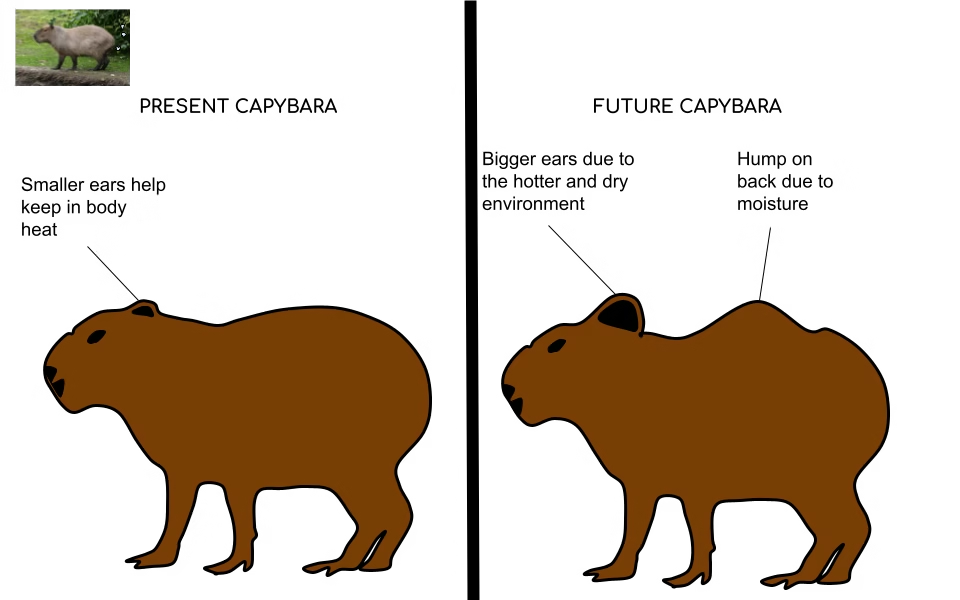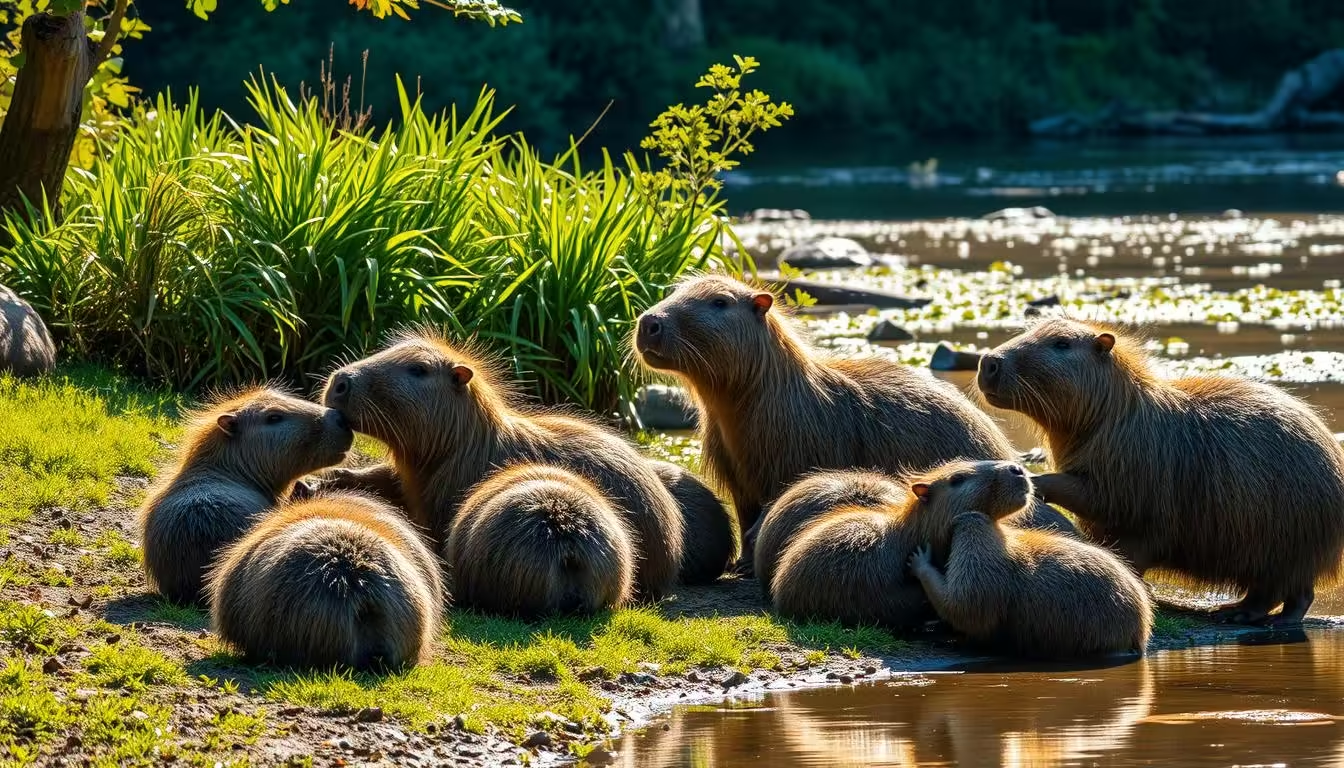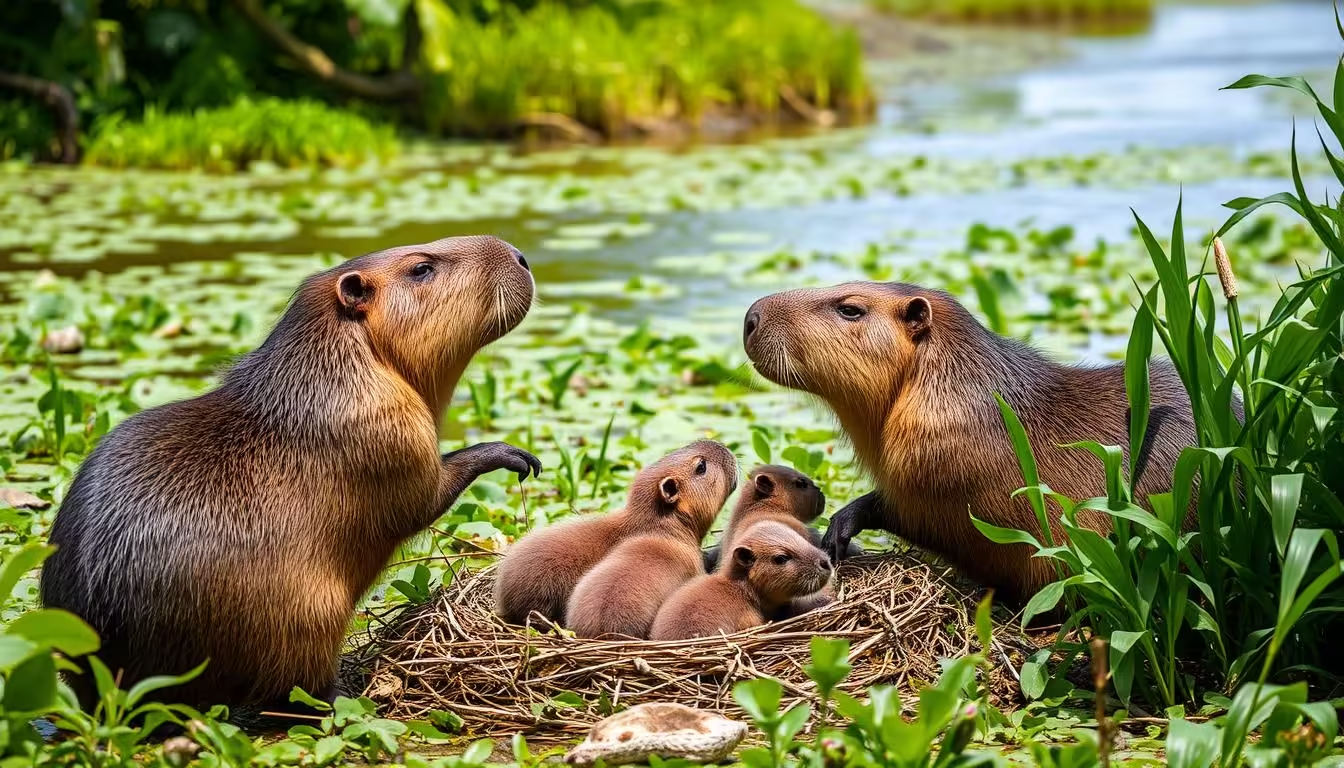Wild capybaras deal with dangers like predators and human activities. They must survive in a complex and dangerous world. This article explores the challenges they face, shedding light on their survival and well-being.
Essential Water Sources and Temperature Conditions
Capybaras can handle temperatures from 4°C (40°F) to 38°C (100°F). They need enough water and shelter. This lets them live in different places, like rainforests, savannas, and wetlands.
Seasonal Habitat Changes and Adaptations
Capybaras adjust to big seasonal changes in their homes. In the dry season, they gather near water sources. But during the flood season, they spread out into smaller groups. These changes help them survive and have babies.
Territory Size and Population Density Factors
The territory size and population density of capybaras change with the seasons. In the dry season, they have bigger territories as they search for water. But in the flood season, they move into smaller groups with smaller territories.
“Capybaras are remarkably adaptable creatures, thriving in diverse aquatic habitats and adjusting their social structures to the changing seasons.”
Predator-Prey Dynamics in Capybara Communities
Capybaras, the world’s largest rodents, face threats from many predators. Predation is a big reason for capybara deaths, with 55% dying from predators like jaguars, caimans, and birds of prey.
The return of apex predators like jaguars in places like Iberá National Park in Argentina has changed things. It has made capybaras always on guard. They change how they move and group to stay safe.
Predators use different ways to catch capybaras. Jaguars sneak up and ambush them, using the capybara’s herd behavior. Caimans hunt in the water, using their strong jaws to grab capybaras at the water’s edge.
“Capybaras are a vital food source for many predators, and their survival is closely linked to the delicate balance of their ecosystem.”
The dangers from capybara predators and the challenges to capybara survival worry conservationists. It’s key to understand the complex relationships between capybara predators and prey. This knowledge helps in protecting these amazing rodents in their natural homes.
Social Structure Impact on Population Survival
Capybaras, the world’s largest rodents, have complex social lives. These lives are key to their survival. They live in groups, usually with ten members, but can grow to 100 in the dry season.
Herd Composition and Hierarchy
A capybara group has a leader male, adult females, and their kids. This setup helps protect them from predators and manage resources. But, it also has downsides, like kicking out younger males when they grow up, which can be risky for them.
Group Size Variations by Season
- In the dry season, capybaras gather in groups of up to 100.
- These big groups offer better protection and access to scarce resources like water.
- When it’s wet, groups get smaller. This lets them spread out to find more food.
Social Bonds and Protection Mechanisms
Capybaras have strong bonds in their groups. These bonds are crucial for their survival. The leader and adult females protect the young and defend their territory. This teamwork helps the whole group survive better than any single capybara could alone.
“The social structure of capybaras is a fascinating example of how collective behavior can boost the chances of survival in the wild.”
How the Challenges of the Wild Shorten Capybara Lifespan
The life of a wild capybara is much shorter than one in captivity. Capybara life expectancy in the wild is about 4 years, compared to 10 years in care. Predation, environmental stress, competition, and human threats all play a role in their shorter lives.
Capybaras, the largest rodents, can weigh between 30 kg and 70 kg. Females are slightly heavier than males. In the wild, they live about 7 to 10 years, much less than their 12-year lifespan in captivity. This shows how tough life is for them in nature.
- Capybaras face threats from predators like anacondas, ocelots, eagles, and jaguars. Young ones are also hunted by vultures, foxes, piranhas, and feral dogs.
- Seasonal flooding and drought, plus climate change, make survival harder for wild capybaras.
- They must fight for food and territory, as these social animals defend their resources against others.
- Human activities like habitat loss, hunting, and pollution also harm their How the Challenges of the Wild Shorten Capybara Lifespan.
Despite these challenges, capybaras are not considered endangered. They are adaptable and can live in many habitats. However, the big difference in life expectancy between wild and captive capybaras shows how tough life is for them in the wild.
Environmental Stressors and Weather Extremes
Capybaras, the largest rodents, face big challenges in their homes. They must handle temperatures from 38°C (100°F) to 4°C (40°F). They need water and shade when it’s hot and warm places when it’s cold.
Seasonal Flooding and Drought Effects
Capybaras also deal with flooding and drought. These changes affect where they live and eat. Flooding blocks their grazing spots, and drought lowers water levels.
Climate Change Impacts
Climate change is a big worry for capybaras. Rising temperatures and changing rain patterns could harm their homes and food. This might make it hard for them to survive.
“The ability of capybaras to thrive in a wide range of environmental conditions is truly remarkable, but the increasing severity of weather extremes and the impacts of climate change present formidable obstacles to their continued success.”
As the climate changes, we need to learn more about capybaras. This knowledge will help us protect these amazing animals.
Reproductive Success and Offspring Survival Rates
Capybaras, the world’s largest rodents, face unique challenges in reproduction and population dynamics. They reach sexual maturity around 15 months in managed care. But in the wild, many factors affect their success, like predation, resource availability, and environmental conditions.
Survival of young capybaras is key to stable populations. Unfortunately, they face threats like predation and competition for resources. These challenges can greatly reduce the number of adults.
- Predation on Young Capybaras: Capybara offspring are vulnerable to predators like jaguars, pumas, and caimans. This can significantly reduce their survival rates.
- Resource Availability: Food and water availability in their habitat affects their reproductive success and offspring survival. Drought or food scarcity can be tough for nursing mothers.
- Environmental Conditions: Changes in temperature, rainfall, and other environmental factors can impact young capybaras. Extreme weather events can be especially harmful.
Understanding these factors is crucial for effective conservation. By addressing these challenges, we can help ensure the long-term viability of capybaras.
“Maintaining stable capybara populations requires a comprehensive understanding of the factors that influence their reproductive success and offspring survival rates in the wild.”
Competition for Resources in Natural Habitats
Capybaras, the world’s largest rodents, face big challenges in their natural habitats. They compete for essential resources. Capybara survival in nature depends on their ability to deal with resource scarcity and territorial conflicts.
Food Availability Challenges
One big obstacle capybaras face is the changing availability of food. In dry seasons or areas with many capybara population densities, finding enough to eat is hard. They mainly eat grasses, aquatic plants, and other vegetation to stay healthy.
Territory Defense Struggles
Keeping their territory safe is key for capybaras. It means they can get to vital resources like water and grazing areas. Dominant males defend the territory, but this can cause fights with others. These fights can be worse during the dry season when food is scarce.
| Resource Competition Factors | Impact on Capybara Survival |
|---|---|
| Food Availability | Fluctuating food sources, especially during dry seasons or in high-density areas, can challenge capybaras’ ability to meet their nutritional needs. |
| Territory Defense | Protecting access to water, grazing areas, and other essential resources through territorial disputes can lead to injuries, displacements, and increased competition within the herd. |
To survive in their natural habitats, capybaras must deal with resource competition. They use their adaptations and social structures to ensure their survival and success.
Human Impact on Capybara Populations
Capybaras, the world’s largest rodents, face many threats from humans. Their numbers have been hurt by hunting and habitat loss. These issues include hunting for their meat and skins, and also for pest control. Habitat destruction from cattle ranching and farming is another big problem.
Hunting is a major threat to capybaras. People want their meat and skins, leading to overhunting. Some see them as pests, causing more harm to their numbers.
Habitat loss is also a big challenge. Land is being cleared for farming and ranching. This reduces the space capybaras have and makes it hard for them to find food and water.
Efforts like those in Iberá National Park in Argentina try to help. They protect capybara habitats and reintroduce them where needed. But, human-wildlife conflict and habitat loss are still big hurdles for capybaras in many places.
| Threats to Capybaras | Impact on Populations |
|---|---|
| Hunting for skins, meat, and pest control | Reduced numbers, especially in areas with high demand for capybara products |
| Habitat destruction due to cattle ranching and agricultural expansion | Loss of natural wetlands and forests, leading to declining habitats and resources |
| Human-wildlife conflict | Ongoing challenges in mitigating issues such as crop damage and perceived threats to livestock |
To help capybaras, we need to do many things. We must strengthen conservation, promote better land use, and teach people about these animals. They are unique and very important for our ecosystem.
Disease and Health Challenges in Wild Populations
Wild capybara populations face many health challenges. These include common parasitic infections and diseases. These issues can greatly affect their survival and the health of the population.
As members of the Rodentia order, capybaras share traits with other rodents. They have different ecological strategies and anatomy. This makes them susceptible to diseases.
Common Parasites and Infections
Capybaras can carry diseases that affect humans and animals. They are reservoir hosts for various pathogens. This raises concerns about zoonotic diseases.
These mammals have internal parasites that can harm their digestive and respiratory systems. It’s important to monitor these infections. This helps us understand and tackle health issues in wild capybara populations.
Natural Immunity Development
Wild capybara populations develop some immunity to local pathogens. However, changes in the environment or new diseases can be threats. Factors like habitat loss, climate change, and human activities can disrupt their health.
Research and monitoring are key to keeping these unique rodents healthy. They help ensure the long-term conservation of capybaras.



